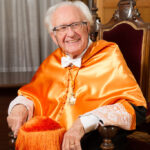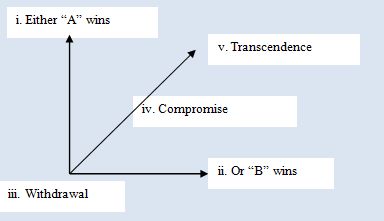The TRANSCEND Method is based on the central thesis that to prevent violence and develop the creative potential of a conflict, there has to be transformation. At the root of the method is the understanding of conflict as incompatible goals, meaning as a problem to be solved; not as incompatible parties (persons, countries etc.), meaning as one or more parties to be controlled (usually not oneself).This training manual from the United Nations Disaster Management Training Programme (DMTP) gives an overview of the approach and explains how to put it into practice. Transforming a conflict requires transcending the goals of conflicting parties, defining other goals, disembedding the conflict from its original situation and embedding it in a more promising place. This is achieved through dialogue based on empathy, non-violence and joint creativity. Failure to transform conflicts leads to violence.
A conflict has its own life cycle. Normal conflicts are complex and involve many actors, goals and issues. Incompatible goals can breed contradictions, which – combined with attitudes of hatred and violent behavior – generate conflict. Violent cultures (which legitimize violence), violent structures (which exploit and alienate) and violent actors can combine to produce basic conflicts, which, if unattended, can spiral into meta-conflicts. The task is to transform conflicts, through a focus on cultures, structures and actors, by finding positive goals for all parties and imaginative ways of combining them.
The TRANSCEND Method has six basic premises, drawn from Hindu, Buddhist, Christian, Daoist, Islamic and Judaic thought respectively. These include: consideration of conflict as a source of both violence and development; mutual causation and shared responsibility; and the importance of dialogue. Ultimately the TRANSCEND Method aims to help bring parties together in a self-sustaining process.
- Transcendence means redefining the situation so that what looked incompatible is unlocked, opening up a new landscape. Creativity, and its application to contradictions, is the key.
- It is important to map out the conflict formation and to include all parties, goals and issues, remembering to bring in forgotten stakeholders.
- Initial dialogue is undertaken with each party individually to identify valid goals, eliciting creative approaches from all parties to find ways of transcending incompatibilities.
- Specific goals should be identified that are acceptable to each party individually in order to arrive at overarching goals that are acceptable to all parties collectively.
The primary tool is empathetic, respectful dialogue that explores the conflict. Important considerations are included in the code for conflict or peace workers applying the TRANSCEND Method:
- Identify positive elements in the parties and the conflict itself to create the potential for further development. Emphasize shared roots and responsibilities, rather than distributing blame and guilt.
- Be creative and suggest alternative courses of action. Collectively find a short, memorable outcome formula, for example ‘sustainable development’, that may not do justice to all complexities, but may facilitate communication.
- Do not demand consensus, commitment or co-operation from parties who are not ready. Equally do not ‘deform’ the conflict by pushing agendas too far away from the parties’ immediate concerns.
- Do not manipulate. Be open and honest with yourself and others about aims and feelings, remembering that the conflict worker’s task is to empower.
- Do not judge. Retain confidentiality and do not seek publicity or gratitude.
- Remember that conflict work is the art of the impossible, requiring optimism, idealism of the heart and realism of the brain.
TO READ FULL PAPER DOWNLOAD PDF FILE HERE
Source: Galtung, J., 2000, ‘Conflict Transformation by Peaceful Means (The TRANSCEND Method)’, participants’ and trainers’ manual, United Nations Disaster Management Training Programme, Geneva
____________________________________________________
 Johan Galtung (24 Oct 1930 – 17 Feb 2024), a professor of peace studies, dr hc mult, was the founder of TRANSCEND International, TRANSCEND Media Service, and rector of TRANSCEND Peace University. He was nominated for the Nobel Peace Prize numerous times and was awarded among others the 1987 Right Livelihood Award, known as the Alternative NPP. Galtung has mediated in over 150 conflicts in more than 150 countries, and written more than 170 books on peace and related issues, 96 as the sole author. More than 40 have been translated to other languages, including 50 Years-100 Peace and Conflict Perspectives published by TRANSCEND University Press. His book, Transcend and Transform, was translated to 25 languages. He has published more than 1700 articles and book chapters and over 500 Editorials for TRANSCEND Media Service. More information about Prof. Galtung and all of his publications can be found at transcend.org/galtung
Johan Galtung (24 Oct 1930 – 17 Feb 2024), a professor of peace studies, dr hc mult, was the founder of TRANSCEND International, TRANSCEND Media Service, and rector of TRANSCEND Peace University. He was nominated for the Nobel Peace Prize numerous times and was awarded among others the 1987 Right Livelihood Award, known as the Alternative NPP. Galtung has mediated in over 150 conflicts in more than 150 countries, and written more than 170 books on peace and related issues, 96 as the sole author. More than 40 have been translated to other languages, including 50 Years-100 Peace and Conflict Perspectives published by TRANSCEND University Press. His book, Transcend and Transform, was translated to 25 languages. He has published more than 1700 articles and book chapters and over 500 Editorials for TRANSCEND Media Service. More information about Prof. Galtung and all of his publications can be found at transcend.org/galtung


I’m happy to know that dear Johann, in the last years of his life, agreed with me.that there is no alternative. Politicians are NOT miracle producers. They cannot promote sales, exports of their national war industry products and Peace simultaneously.
Bless you, Johann,
Alberto